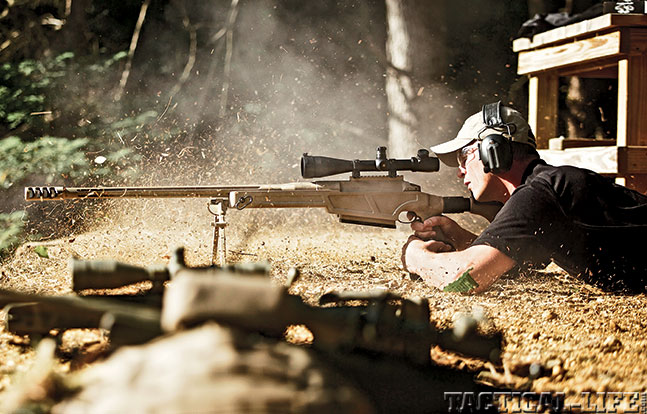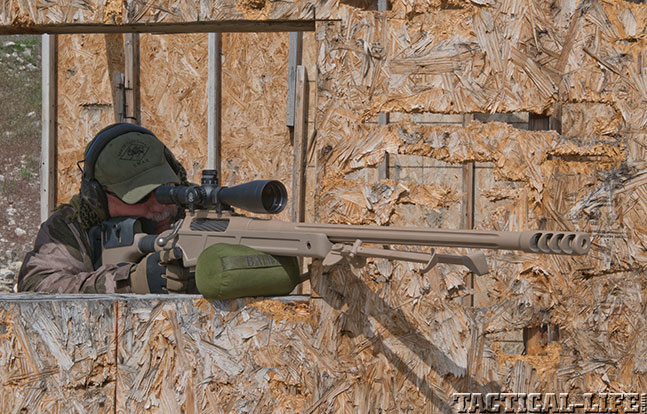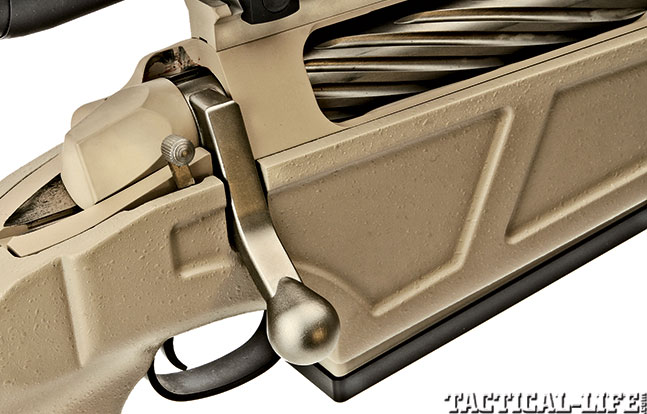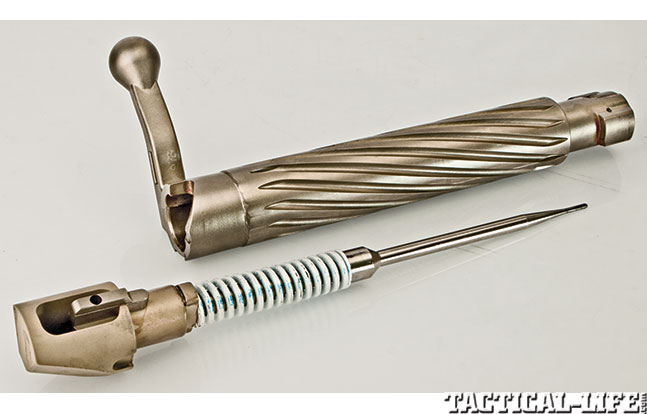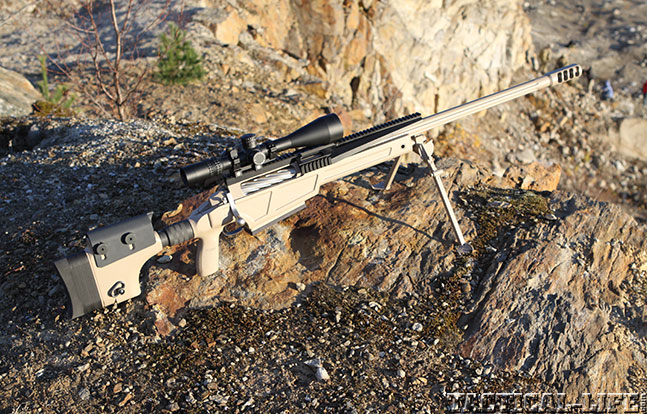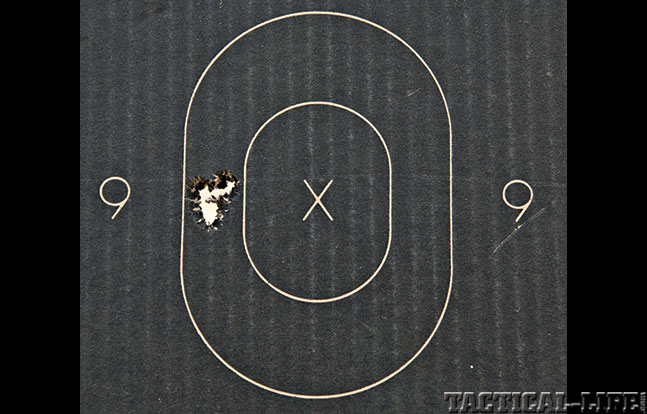For most military and police applications, the .50 BMG’s primary tasks are generally anti-materiel in nature at long range. Undoubtedly, the .50 BMG’s forte is delivering significant energy and penetrating hardened targets. This is precisely what makes it so well suited to stopping armored vehicles, drug-smuggling boats and other vehicles. The byproducts of all that energy, however, are significant recoil and a rather impressive muzzle blast. Not everyone can or wants to run .50-caliber guns, especially in a bolt-action rifle. The recoil can be painful, staying on target for follow-up shots is mostly wishful thinking, and the muzzle blast will shake windows 50 yards away. Lighter .50 BMG rifles weigh a little less than 25 pounds; add extra ammunition and support gear and you are rapidly approaching what used to be a crew-served weapon.
- RELATED: Sig Sauer’s MPx 9mm SMG Is a Compact Powerhouse
- RELATED: Gun Review: Sig Sauer SSG 3000 Patrol 7.62mm
Even with all its drawbacks, when you need a .50 BMG there is really nothing better, and while some applications will work with minute-of-truck accuracy, there are times when greater precision is necessary. Precision rifles in this caliber have been around for years, and they’ve been used with great effect in a number of conflicts. One of my best friends carried and used one as an Army Ranger. Competitive shooters still use them today, and many have seen use in antiterrorist units and SWAT teams where precisely delivering serious energy on target is critical. Some of these weapons are single-shot rifles, but most are magazine-fed bolt actions. With the right ammunition, these guns can be truly accurate. Sig Sauer’s SIG50 is just such a rifle, and it’s capable of some rather impressive groups.
Advertisement — Continue Reading Below
Big .50 Specs
Like many of the most accurate .50 BMG rifles, the SIG50 starts with a proven bolt-action receiver built by McMillan. This system has seen significant action in military rifles and dominates benchrest competitions in this caliber. It is strong, smooth and capable of extreme accuracy. Sig Sauer has the SIG50’s action built to its high standards using a more angular design. The receiver is machined from 4340 chrome-moly steel and heat-treated to 45-48 Rockwell, making it as tough as nails. Topping the action is a full-length, 30-MOA rail to accommodate the scope of your choice.
“Sig Sauer’s SIG50 is a proven design that is about as accurate as you can get.”
Advertisement — Continue Reading Below
Even tougher 9310 steel is used for the bolt, which is carburized to 60 Rockwell. Helical fluting reduces weight and adds reliability. The oversized tactical bolt handle makes for smooth operation and will clear most large scopes. The rifle utilizes metal, five-round magazines, and the single-stage trigger, tuned to 3.5 pounds, is adjustable. The action is mated to a 29-inch, fluted, stainless steel, match-grade barrel with a 1-in-15-inch twist rate. Sig Sauer caps the barrel with a four-port muzzle brake designed to tame recoil and redirect muzzle blast away from the shooter.
The SIG50’s buttstock locks solidly in place and detaches, allowing the rifle to be easily stored and transported. The buttstock is also adjustable for cheek height, and shooters can remove spacers to adjust the length of pull. The stock has a contoured pistol grip that puts the rifle solidly in your shoulder pocket, and out front is an all-steel bipod for stability. Flush cups at the front and rear of the stock accommodate quick-detach (QD) sling swivels. Finally, the SIG50 rifle is coated with a tan, anti-glare Duracoat finish, making it ready for years of hard use.
For testing, I mounted Leupold’s 3.5-25x56mm Mark 8 scope. Using a 35mm tube and indexed matched lenses, it is incredibly clear and rugged. An illuminated mil-dot reticle is mounted in the first focal plane (FFP), and the illumination is controlled using a side-mounted knob with several levels. The zoom ratio provides plenty precision without sacrificing your field of view. M5B2 knobs with “pinch and turn” activation keep things locked in place until you need them. Each rotation, in 0.1-mil increments, provides a tactile click, making adjustments without looking at the knobs easier.
Advertisement — Continue Reading Below
Sub-MOA Precision
Normally, testing a .50 BMG’s accuracy at less than 300 yards can be problematic. Like many large-bore rifles, they tend to group better at 300 yards than 100 yards. That’s what I’ve seen over the years—tighter groups at longer distances. Many will zero these rifles at 300 yards or more, but not all, especially those in law enforcement, where a 100-yard zero remains the norm. Most police agencies are looking to take out an engine block or hardened targets within 100 yards, so grouping at this distance is important. On the other hand, those with real long-range needs may zero the rifle at 500 yards—it just depends on what you are doing with the rifle.
Advertisement — Continue Reading Below
“This rifle was definitely far from typical, producing one of the best 100-yard groups I’ve ever fired with a .50 BMG rifle.”
Having used similar rifles over the years, achieving 1-MOA results at 100 yards is pretty good. Rifles with this much recoil just don’t lend themselves to shooting tiny little groups. Even if the rifle will shoot that accurately, it is difficult to be consistent with each round. Staying locked into the rifle and not moving off of the target is all but impossible. This rifle was definitely far from typical, producing one of the best 100-yard groups I’ve ever fired with a .50 BMG rifle.
At the range, I loaded some Hornady 750-grain A-MAX rounds and fired a five-shot group at 100 yards from prone, pretty much creating one hole that measured 0.49 inches center to center—which is very impressive considering the .50 BMG bullet has a 0.51-inch diameter. I was so astounded that I measured the hole several times with my calipers to be certain, as it was the first time I’ve ever made a group tighter than half an inch at 100 yards with a .50 BMG rifle. The bottom line: This rifle is about as accurate as it gets short of using a benchrest gun with handloads.
Advertisement — Continue Reading Below
Moving out to 300 yards, the same ammo held very close to 0.5 MOA with a group measuring 1.60 inches. It remained quite consistent at this distance, with everything grouping under 1.75 inches at 300 yards. There was no real loss in consistency at 500 yards, either, with groups averaging 3 inches. Hornady’s A-MAX load took the day here as well with a best group measuring 2.75 inches.
Running the SIG50 was pretty comfortable as these things go. At the end of a couple days on the range, my shoulder was no sorer then a couple long days with a 12 gauge and buckshot, maybe a bit less. The recoil impulse is sharp, but it’s over quickly and the muzzle brake does its job well, as it kept the blast mostly away from me and did not kick up much debris at the range.
This was not a new gun, but one that had been fired previously, so the action was well broken in. It was smooth to run the bolt, with no excessive lift required with any of the ammunition tested even during a more rapid-fire string. While not able to run it lightning fast, it was quick and smooth, with no failures to eject. So long as the bolt was run hard it never failed to feed. The trigger was very predictable, clean, crisp and conducive to repeatable accuracy.
Advertisement — Continue Reading Below
On-Demand Power
I’ve always preferred removable buttstocks on these types of rifles. Folding stocks can work, but this design ensures things stay solid. Big .50 BMG rifles like this will never be portable, per se, but some are just downright unwieldy. If it is used as a deployment rifle you still need to get it in place, and carrying it around in a hard case is less than ideal. You will also need a specially designed case if it’s to be carried fully assembled. Removing the stock, the SIG50 fit in both my Eagle and Galati bags, and both would work fine for typical police deployments. For longer treks or tracking, the rifle fit very well in my Eberlestock G4 Operator bag along with magazines, extra ammo, and even my Bushnell spotting scope and all of its attachments.
Advertisement — Continue Reading Below
Leupold’s Mark 8 scope worked very well. The glass is exceptionally clear, rivaling any foreign-made scope on the market today. With a 3.5-25X magnification range, it is about as versatile as it gets. Police officers may want the field of view that comes with the lower power, yet 25X magnification is about as powerful as you can go and remain usable, especially where any appreciable mirage exists. Leupold’s pinch-and-turn adjustment knobs are excellent. Large and easy to read, the knobs did not shift during transport or low crawls, yet they are pretty easy to move when needed. They were tactile, easy to adjust without looking, and the scope held its zero despite the .50 BMG recoil. These days the mil-dot reticle would not be my first choice, but for many longtime operators they remain a preference. For those in need of a ranging reticle, the Mark 8 is available with Horus H-58 and Tremor 2 reticles, also in the first focal plane.
There is no doubt that the big .50 BMG has a place in the tactical environment, and it likely will for many years to come. For large, hardened targets where rapid fire is needed, semi-autos are still preferable. If you need precision at any range, bolt actions are still the best choice. Sig Sauer’s SIG50 is a proven design that is about as accurate as you can get. If you need a truly accurate .50 BMG precision rifle, make sure you give the SIG50 a very close look.
For more information on the SIG50, visit sigsauer.com or call 603-772-2302.
Advertisement — Continue Reading Below
